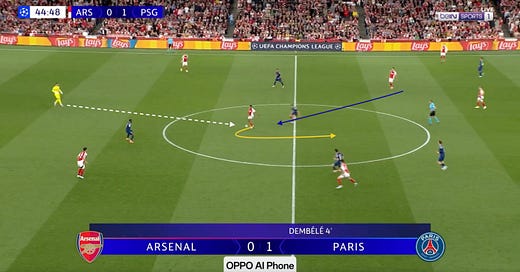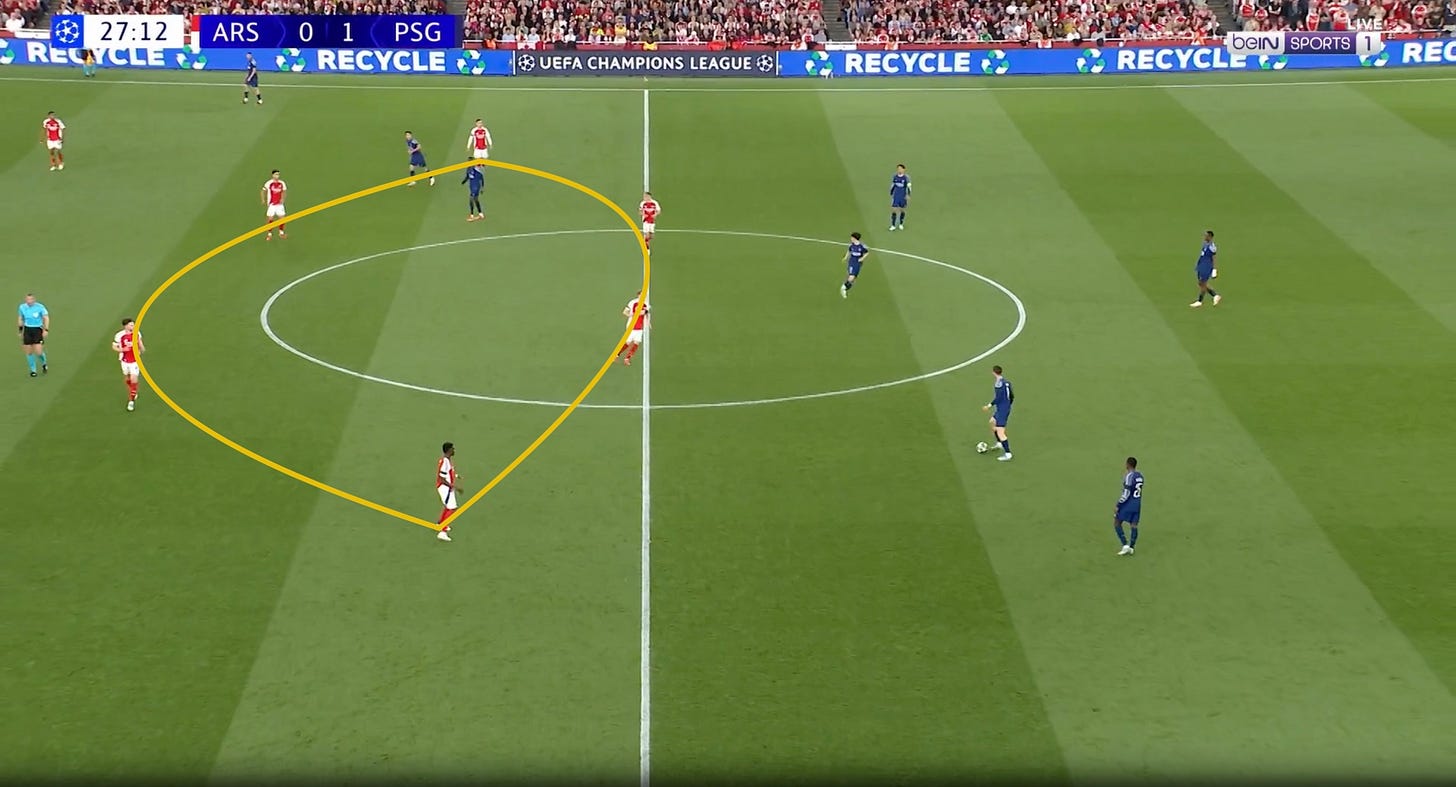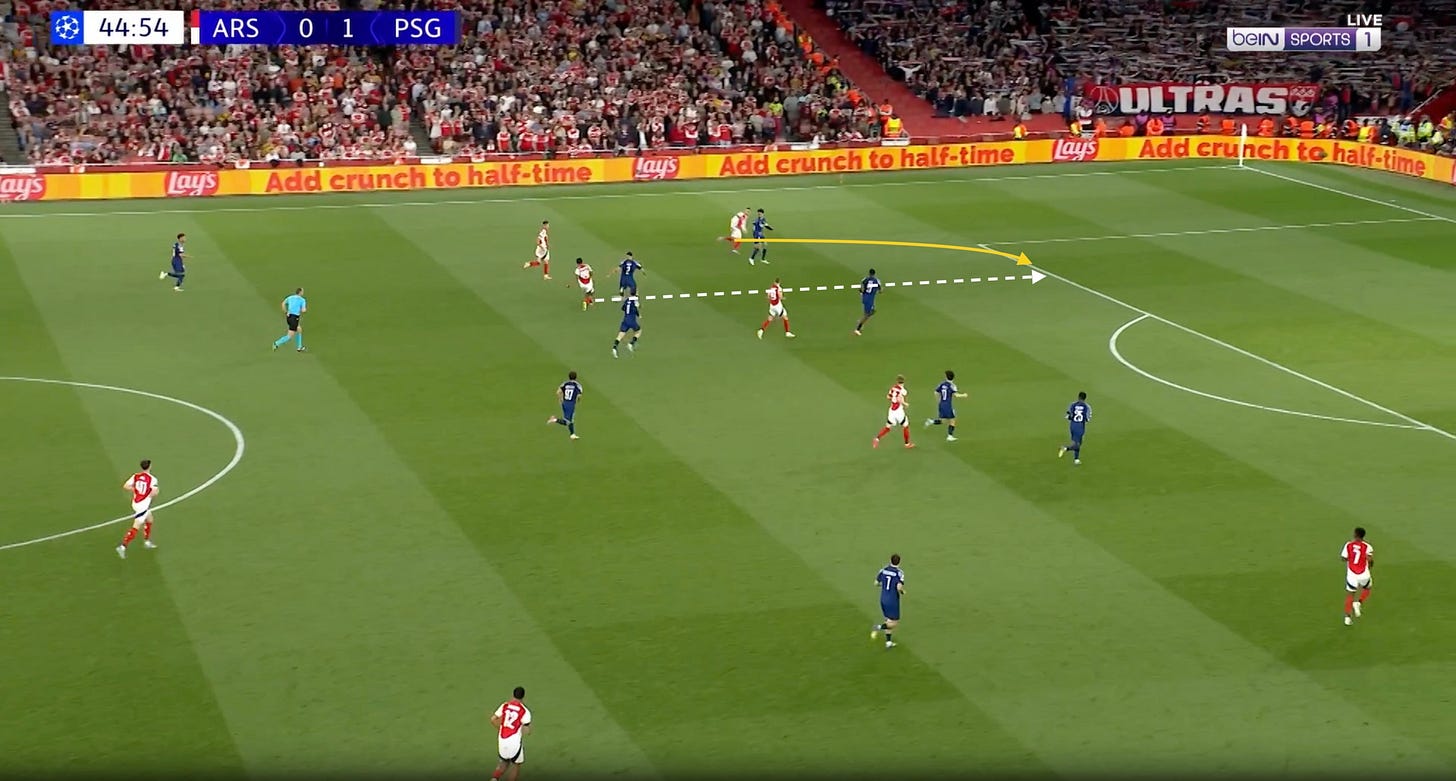First leg lessons for Arsenal in Paris
The Arsenal press, trusting the block, and where PSG are vulnerable
The post-mortem can wait. Stick your transfer target talk on ice. Hold those horses when it comes to finger-pointing and untwist those knickers. Arsenal are only halfway through a Champions League semi-final. Don’t you want to see how it all ends?
Arsenal are a goal down heading into Wednesday’s second leg against PSG but nothing is over, nobody is out (ignore the still massive injury list), we’re still standing.
The post-mortem obviously does need to happen but none of that needs to be rushed, there’s an entire Arsenal-less summer to fill no matter what happens next. The time to dissect will come.
Now, though, it’s time to head to Paris. Of course the French capital, the setting for Arsenal’s sole Champions League final appearance way back in 2006, would provide the final hurdle as the Gunners look to finally make their way to the biggest game in club football again.
And of course it looks like an uphill battle. Going into Wednesday’s second leg, Arsenal look tired, seem to be lacking confidence, are certainly lacking some players, are a goal down (but it is just one goal), and now have to play away from home against a side that, for almost half an hour, ran rings around them in north London a week ago.
But only for half an hour. If that.
I can understand why last week’s game would leave so many feeling pessimistic about Arsenal’s chances in Paris, but there are other ways of looking at it.
If you’re looking for a glass half full take: playing a team twice in such a short amount of time gives you the chance to learn from the first game and take those lessons into the second one.
If you want some real, wholehearted optimism: after the first 20-25 minutes because Arsenal had already the lessons they had to learn really, really quickly and were probably the better side, leaving aside the fact some fresh legs offered PSG a bit more threat on the break late on.
From minute 32 to minute 77, PSG had one shot last week, with Khvicha Kvaratskhelia attempting to catch David Raya out from near the halfway line. Arsenal had seven efforts and a goal disallowed in that time. Arsenal were frustrated by a good team, but PSG were tested.
The test this week is to see if Arsenal learned enough from the opening spell at the Emirates to handle PSG better this time around.
Lesson one: Man-mark in midfield when pressing, man-mark Dembélé, be aggressive
The main lesson came without the ball. PSG’s movement caused Arsenal problem after problem both when the Gunners pressed and when they sat off.
When building from deep high, PSG were happy to have their midfielders far apart: Vitinha would drop deep, joining the backline, Fabian Ruiz and Joao Neves would not get involved there but would make runs in behind or way out to the touchline, Ousmane Dembélé would drop into those vacated midfield areas. Arsenal were stretched and overloaded, players seemed to each have two jobs — a man, two men, an area — to cover and did not look confident in what to do. The PSG goal featured all of these elements, with Arsenal pulled apart.
An early change made a huge difference, with Martin Odegaard sitting on Vitinha and following the Portuguese wherever he went. Declan Rice and Mikel Merino did the same, sticking more tightly to Fabian Ruiz and Joao Neves. And as the game went on, the Arsenal centre-backs (but particularly William Saliba) were more aggressive in following Dembélé when he dropped into midfield too.
It’s risky, and I think Arsenal would be a lot more comfortable doing this with Gabriel in the side rather than Jakub Kiwior, but the change gave the team a foothold last week and it’s time to double down in Paris. A semi-final is not the time to be knocked out wondering if you could have been braver.
Lesson two: Trust the defensive block
Defending in a 4-4-2 block is usually something Arsenal look really comfortable in. Whether that’s higher upfield, with the strikers around the halfway line, or on the edge of their own box, Arteta has his team well-drilled enough to confidently say: go on then, try to break us down.
Maybe it was the occasion, maybe it was the early goal, maybe it was the quality of the opposition, but that confidence wasn’t there early on last week. The Arsenal block was dragged around. The PSG midfielders would drift wide outside of the block into areas where they were not in a position to be particularly dangerous, and they would successfully bring an Arsenal player with them, stretching the team and creating spaces to play into.
If that block is set and Vitinha wants to drop outside it to have the ball next to his own centre-backs, let him. If Fabian Ruiz drifts to the touchline to receive possession, fine. There’s a reason Arsenal struggle to break these blocks down themselves (it’s really difficult!) and the opposition dropping midfielders deep (like in the example below) or wide rather than flooding the middle of the pitch is not something to be overly concerned about.
The team does need to shuffle across but no individual should be dragged out of position, allowing PSG to open up spaces to play through. Pass men on, move as a unit, keep those distances consistent.
Lesson three: Attract the press, pull Hakimi out, hit the flank
When Arsenal played out from the back patiently, they usually got somewhere. The crowd could get a bit twitchy when it looked like too much time was being taken or too many passes were being played, but PSG were aggressive without fully committing. As a result, Arsenal, barring any poor passes, could usually eventually get a man advantage, then find that spare man and have him turn into space to launch an attack.
That job is perfect for Myles Lewis-Skelly, who spun away from Achraf Hakimi to launch the move that saw Gabriel Martinelli denied by Gianluigi Donnarumma.
It is also perfect for Declan Rice, who drove beyond Hakimi (who was again closing down Lewis-Skelly) to launch the move that saw Leandro Trossard denied by Donnarumma.
Both of Arsenal’s best chances came down Hakimi’s side with the Moroccan nowhere to be seen. Not because he was getting too far forward in attack, but because he pinches inside to join the press. A right-back by trade, he is not part of the backline when PSG press, nor is he is on the touchline either. As a result, when Arsenal broke through, Marquinhos was the man out wide, monitoring Martinelli. In the first instance, Martinelli ran in behind him, for the second chance, the Arsenal winger drove inside without the ball and took Marquinhos with him to open space for Trossard as he drifted to the flank.
More one-on-one races between Martinelli and Marquinhos are something Arsenal should be keen to explore if PSG have the same pressing shape.
Obviously it is likely to be Mikel Merino up front this time around, offering a better presence in the box for crosses and a bigger focal point for long balls from the back and that could help Arsenal’s build up play too. The option to go long and win that duel means there can be more variation, more flexibility, and ultimately more options PSG have to consider before committing one way or another to either pressing high or sitting off.
And here we are. It’s been a long season. It hasn’t been fun, for the most part. But football is strange, and Arsenal need to win one game to reach a Champions League final.
PSG’s performance in the first leg was, for my money, the best Arsenal have faced all season. Yet this Arsenal — physically decimated, confidence knocked by an early goal, playing a first Champions League semi-final in 16 years and first ever for this manager and this group of players — held their own, took the early setback on the chin, and competed.
One win from the final. It’s all to play for.









nice one! more like this!
Nicely done